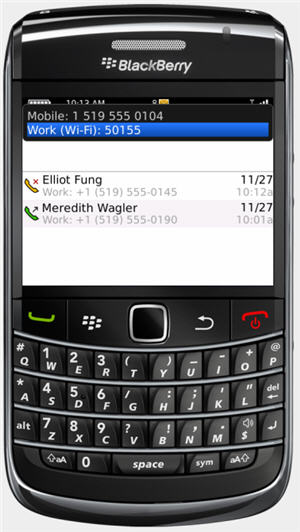RIM melds BlackBerry with PBX handsets

Research in Motion's latest version of its mobile voice system (MVS) allows you to morph your BlackBerry into your corporate handset.

For the worker, the latest MVS allows for easier call handling and toggling between mobile and corporate phone systems. The enterprise gets better control over policies and can save on international and roaming charges since MVS can operate over Wi-Fi networks.
While PBX-BlackBerry connections may not be glamorous for folks tracking the latest smartphone, RIM's move could be a big deal for the enterprise. Alan Panezic, vice president of RIM's platform product management group, said that CIOs are aware of the so-called one number problem. Too much time is wasted calling people at various mobile and PBX numbers. Connecting the two---think of an enterprise-grade secure Google Voice---could be well received.
IDC estimates that the global number of mobile workers will swell to 1.19 billion by 2013. Of that sum, 65 million are home-based. The shift means that companies are going to need to make it easier to toggle between cellular and PBX lines.
MVS also allows a worker to see the same display---incoming and parked calls for example---on their BlackBerry that he would see on a desk phone. Via the BlackBerry, a worker could take calls and make and move them.
Andrew Nusca and I got a quick demo from Panezic and the new functionality looked handy. For RIM, the latest MVS is another effort to solidify the company's standing in the enterprise. While consumer devices have been a key focus of RIM's efforts, the enterprise is the company's real beachhead. Simply put, device makers are building hooks into the enterprise with their platforms, but wouldn't bother building things like the MVS.
Among the key items in MVS:
- RIM built in the ability to support Wi-Fi and VoIP. For instance, a U.S. worker visiting a Paris branch office could connect to the corporate PBX without charges. MVS previously only connected to the cellular network. Now, with Wi-Fi network access, it's useful for spotty coverage -- or use it to reduce costs. "This will enable new possibilities for mobile workers and home-based workers," said Manish Punjabi, senior director of collaborative mobile voice at RIM.
- There's support for 25 virtual private networks.
- Via Wi-Fi and encrypted calls the BlackBerry serves as a cordless phone on corporate campuses.
- You can set the BlackBerry to toggle between work and mobile phone numbers based on the time of the day.
- The ability for third parties to build applications for the MVS platform.
- Improved reliability features.
Ten customers have been using the latest MVS system at scale. MVS 5.0 will be available later this year.